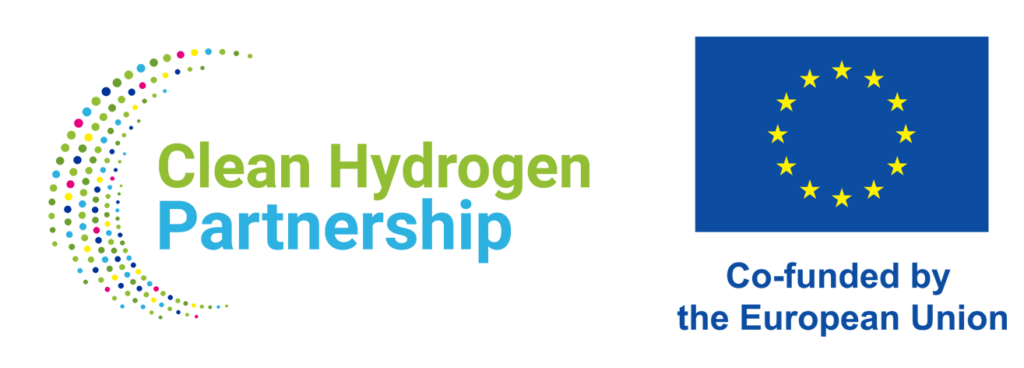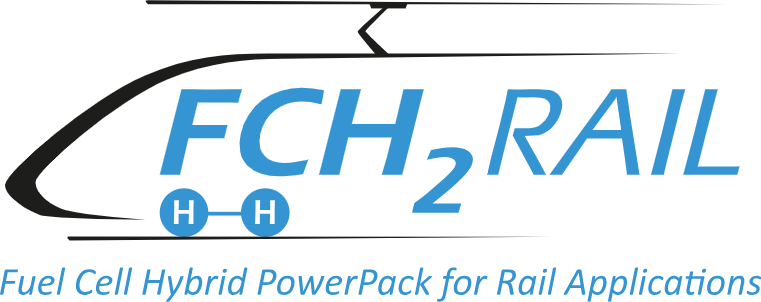
FCH2RAIL project:
First hydrogen train on the Spanish railway network

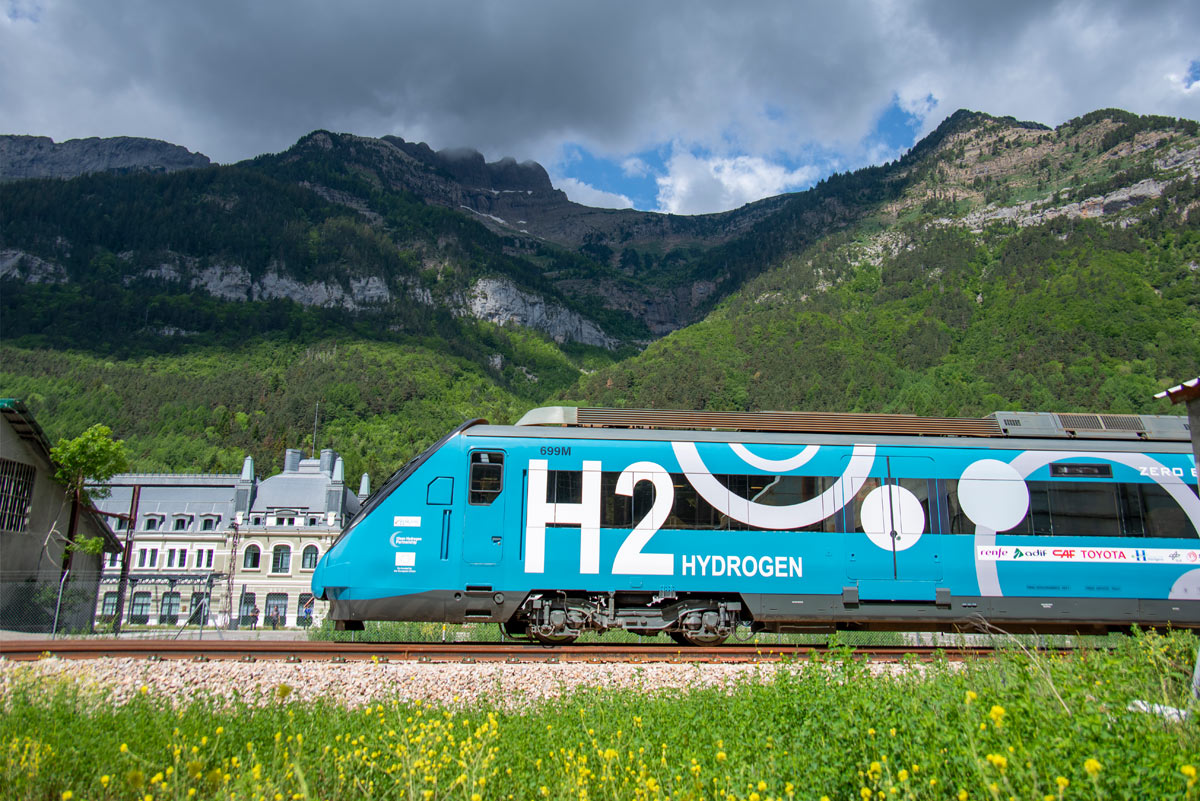
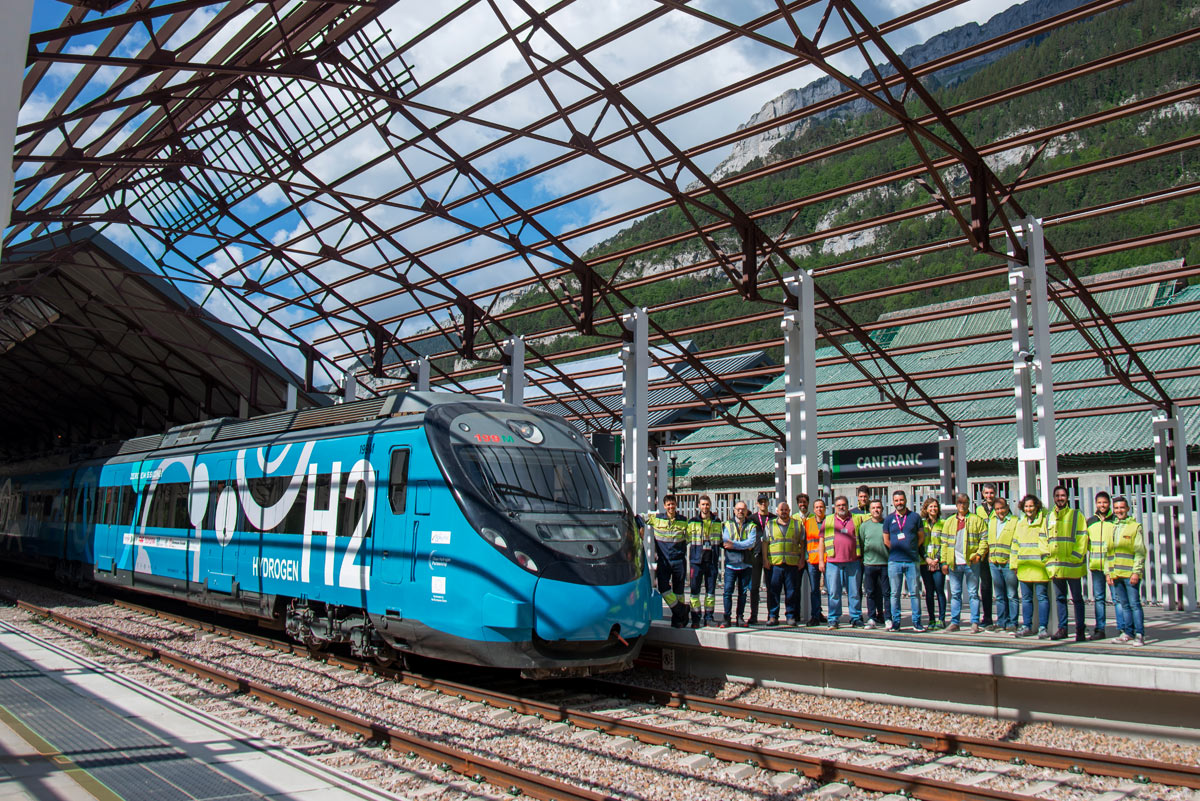
Credit: CAF (CC BY-NC-ND 4.0)
The testing phase in the Spanish tracks has started with the first test run on the Zaragoza-Canfranc line, in the Aragonese Pyrenees and it will continue on lines in Madrid and Galicia.
The FCH2Rail project, in which a bi-mode demonstrator train with hydrogen fuel cells is being developed, has achieved an important milestone by obtaining authorisation to run in tests on the Spanish National Railway Network, and having completed the first of the routes planned with the arrival of the unit at Canfranc station, in the Aragonese Pyrenees. The demonstrator train is the first hydrogen train to achieve this milestone. This is an outstanding highlight, because the Canfranc line is a particularly demanding line due to its steep and high gradients, which involve a great challenge for the new power generation systems. To this end, the demonstrator train, a Renfe’s Civia commuter unit, has run on the Zaragoza-Canfranc line both in electric mode, in the electrified area, and in hybrid mode, combining energy from hydrogen fuel cells and batteries in the non-electrified sections.
- Electric mode
- Hybrid mode (hydrogen fuel cells + batteries)
A new stage of on-track testing is now underway with the aim of testing the new technology in a wide range of power and energy demand conditions, simulating different commercial services. To this end, the train is scheduled to run on different lines of the Spanish Railway Network, mainly on lines in Aragon, Madrid and Galicia. The test scenarios include running under different climatic and operating conditions. This will allow a more complete characterisation of the new on-board technology, for the subsequent evaluation of the competitiveness of the new bi-mode hybrid propulsion solution with hydrogen fuel cells as a sustainable alternative to the diesel traction currently used on many lines.
The FCH2Rail project is being carried out by a consortium of companies formed by CAF, DLR, Toyota, Renfe, Adif, CNH2, IP and Stemmann-Technik. The demonstrator train is based on one existing Renfe commuter train, in which CAF has installed a new power generation system that uses the hybridisation of energy from hydrogen fuel cells and batteries. This new power system has been integrated into the vehicle’s existing traction system. After the static testing phase at the CAF’s plant in Zaragoza and the first hydrogen refuelling, the dynamic tests began in mid-2022 on a closed track, which have served to optimise the new power system prior to the current testing phase on representative lines of the Spanish Railway Network. The start of this new testing phase has meant the first authorisation from Adif for the circulation in tests of a hydrogen train on the Spanish Railway infrastructure, passing all the risk analysis and safety validation processes inherent to the testing of new technologies. At the same time, the train drivers and train managers from Renfe have received the necessary training to drive the CIVIA train converted to a bi-mode hydrogen train.
The success in the development of this project confirms and reinforces the commitment of the companies that make up the FCH2Rail consortium to the development of environmentally friendly mobility solutions. Likewise, the project counts during this stage of the tests on the invaluable collaboration of companies such as IBERDROLA, in terms of the supply of green hydrogen for the train tests, SHIE-ARPA, providing a high-pressure hydrogen dispensing solution, and Ercros, a producer of green H2 for mobility applications, which has facilitated the use of its facilities in Sabiñanigo during the testing stage between Sabiñanigo and Canfranc.
Our Motivation
Overhead line and hybrid system:
Bi-modal, emission-free travelling
The basic idea: Where energy is available from overhead lines, the train continues to run on it. Where there are no overhead lines, the energy comes from the fuel cell battery system, the “Fuel Cell Hybrid Power Pack”. “We want to show that this type of bi-mode power pack is a competitive and environmentally friendly alternative to diesel power”, describes project leader and researcher Holger Dittus from the German Aerospace Center – Institute of Vehicle Concepts (DLR).
Across Europe, more and more railway lines are being electrified, i.e. equipped with overhead lines. A very expensive and long-term project that always depends on the local geographical conditions. Purely battery-powered trains have a limited range of 30 to 70 kilometres, depending on the route profile and outside temperatures. Today’s diesel trains have restrictions in speed and acceleration compared to vehicles powered from overhead lines. “Our bi-modal fuel cell battery system combines the advantages of both technologies. This lets us make rail transport even more sustainable and energy-efficient”, says Eva Terron, Technical Project Manager at Construcciones y Auxiliar de Ferrocarriles (CAF), summarising the main goal of the project.
With a budget of 14 million euros, the project aims to develop, demonstrate and approve such a system within the next four years. The project is funded with 10 million euros by the Fuel Cells and Hydrogen 2 Joint Undertaking (FCH 2 JU now Clean Hydrogen Partnership).
Scalable drive unit for efficient production
The energy supply system is to be designed in such a way that power and range can be expanded based on a modular principle: The number of fuel cell and battery modules influences the drive power, the number of hydrogen tanks determines the range on non-electrified lines. This way, the drive unit can be designed for use in both passenger and freight transport. This design also makes it possible to produce the required components in greater numbers and thus more cost-effectively.
Put on track:
Functional tests with converted commuter train
Which railway lines are suitable for trial runs in Spain and Portugal? And what are the environmental impacts of such a system, from its production, to its use, up to its disposal? To answer these question in a test under real conditions, it is planned to convert a CIVIA electric commuter train from the Spanish manufacturer CAF and to integrate a fuel cell hybrid power pack. The Spanish state railway company Renfe Operadora is providing the train. The central components are fuel cell systems from Toyota Motor Europe (TME). Initial functional tests and trial runs for approval are to take place on Spanish and Portuguese tracks with the support of the infrastructure managers Administrador de Infrastructuras Ferroviarias (ADIF) and Infraestruturas de Portugal (IP). The Spanish hydrogen research centre Centro National de Hidrogeno (CNH2) has been entrusted with the construction of a hydrogen fuelling station to refuel the prototype.
Designing and controlling the system, energy management and homologation
Up until the first trial runs, the international project team still has a number of technological challenges to solve: For the design, fuel cell and battery modules must be combined and controlled in such a way that the system meets all requirements and can be implemented cost-effectively at the same time. In addition, it should be possible to use the waste heat from the fuel cell as cleverly as possible to heat and air-condition the train. The air conditioning manufacturer Faiveley / Stemmann Technik (STT) and DLR are investigating innovative solutions for reducing the energy demand for heating, ventilation and air conditioning (HVAC) as part of the project. In addition Stemmann analyses the interaction of the pantograph system with hydrogen systems.
Another critical issue is the safe interaction of hydrogen technology and overhead catenary at all times: This is because hydrogen is a highly volatile and reactive gas, and overhead catenaries can occasionally cause a spark. The project therefore examines norms and standards in the fields of hydrogen and rail transport and attempts to bring the two together. Based on this, the project team is developing proposals for approval authorities so that such trains can be approved more easily across the EU in the near future.
Duration
01/2021 – 12/2024
Partners
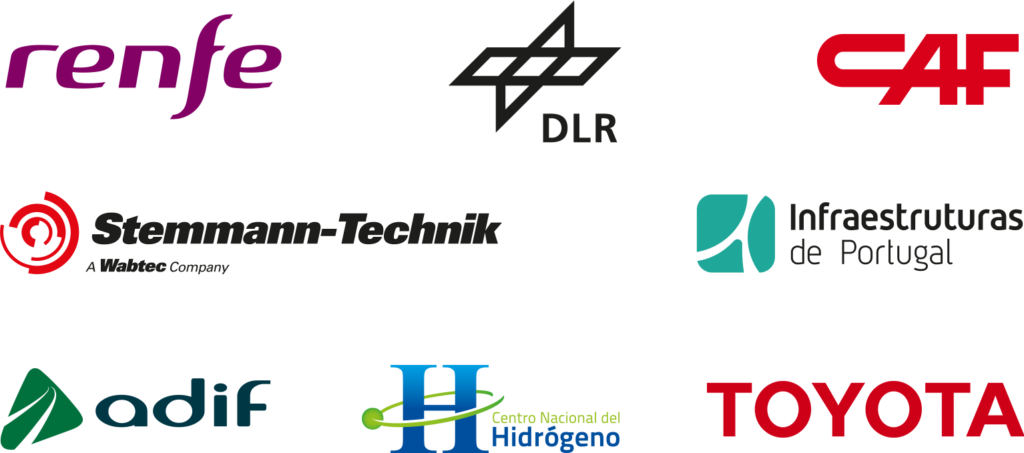
Handout





